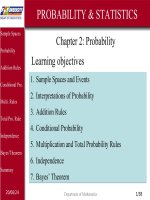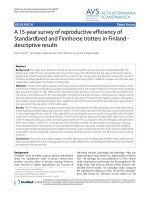Statistics in geophysics descriptive statistics
Bạn đang xem bản rút gọn của tài liệu. Xem và tải ngay bản đầy đủ của tài liệu tại đây (304.17 KB, 32 trang )
Setting the scene
Frequency distributions
Statistics in Geophysics: Descriptive Statistics
Steffen Unkel
Department of Statistics
Ludwig-Maximilians-University Munich, Germany
Winter Term 2013/14
1/32
Setting the scene
Frequency distributions
Population and sample
Variables
Types of measurement scales
Background
Observing systems and computer models in geophysical
sciences produce torrents of numerical data.
One important application of statistical ideas is in making
sense of a set of data.
The goal is to extract insights about the processes underlying
the generation of the numbers.
Descriptive statistics is the discipline of quantitatively
describing the main features of a collection of data (sample).
More recently, a collection of summarisation techniques has
been formulated under the heading of exploratory data
analysis.
Winter Term 2013/14
2/32
Setting the scene
Frequency distributions
Population and sample
Variables
Types of measurement scales
Elementary unit and population
Definition: Elementary unit
Objects for which a statistical analysis is desired
Symbol: ω
Definition: Population
Aggregation of all elementary units defines a population
Symbol: Ω
ωi ∈ Ω, i = 1, . . . , N
N is the size of the population
Winter Term 2013/14
3/32
Setting the scene
Frequency distributions
Population and sample
Variables
Types of measurement scales
Elementary unit and population
Example: Households in Germany
ωi : a household in Germany
Ω: all households in Germany
Population size N: about 40.1 million (as of 2008)
Example: Fish in a lake
ωi : a fish in a lake
Ω: all fish in a lake
Population size: ?
Winter Term 2013/14
4/32
Setting the scene
Frequency distributions
Population and sample
Variables
Types of measurement scales
Sample
Definition: Sample
A sample is a subset of the elementary units, drawn from the
population by means of a sampling method (e.g. random
sample).
Sampling theory is concerned with the selection of a subset of
individuals from within a statistical population to estimate
characteristics of the whole population.
Sample size: n (n < N)
Statistical analysis of the sample allows us to draw conclusions
about the population of interest (inferential statistics)
Winter Term 2013/14
5/32
Setting the scene
Frequency distributions
Population and sample
Variables
Types of measurement scales
Variable and values of a variable
Definition: Variable or statistical variable
Properties, characteristics or attributes of an elementary unit
Definition: Variable values
The different values a variable can take. The values can be
qualitative: variable values are not numbers, but may be
coded by numerical values. Such variables are often called
categorical.
quantitative: variable values are numbers (numerical values)
discrete: finite or countable set of different values
continuous: uncountable set of different values
quasi-continuous: data are continuous but measured in a
discrete way
Winter Term 2013/14
6/32
Setting the scene
Frequency distributions
Population and sample
Variables
Types of measurement scales
Variable and values of a variable
Examples
Gender: qualitative. Coding: 1=male, 2=female
Hair colour: qualitative. Coding: 1=red, 2=brown, et cetera
Temperature: quantitative, (quasi-)continuous
Number of car accidents in 2012 in Germany: quantitative,
discrete
School grades: qualitative. Values: 1,2,3,4,5,6
Winter Term 2013/14
7/32
Setting the scene
Frequency distributions
Population and sample
Variables
Types of measurement scales
Level of measurements
The level at which a variable is measured determines
the choice of numerical summary measures to describe the
main features of the data,
what kind of graphical representations are useful for
exploratory data analysis,
which methods of statistical inference can be applied.
Winter Term 2013/14
8/32
Setting the scene
Frequency distributions
Population and sample
Variables
Types of measurement scales
Measurement scales
Definition: Nominal scale
Lowest level, unordered set of values
Relation or operation: counting values, equality (=)
Units cannot be ordered according to nominal values
No arithmetic operations (addition, substraction, ratio)
possible
Definition: Ordinal scale
Ordered set of values
Relation or operation: counting values, order (<)
Units can be ordered according to ordinal values
No arithmetic operations (addition, substraction, ratio)
possible
Winter Term 2013/14
9/32
Setting the scene
Frequency distributions
Population and sample
Variables
Types of measurement scales
Measurement scales
Definition: Metric scale
Interval scale
All features of ordinal scale
Differences of values are meaningful
Zero value arbitrary
Ratio scale
All features of interval scale
Ratios of values are meaningful
Zero value not arbitrary
Winter Term 2013/14
10/32
Setting the scene
Frequency distributions
Population and sample
Variables
Types of measurement scales
Measurement scales
Examples: nominal scale
Hair colour
Gender
Examples: ordinal scale
How often in a week do you eat carrots?
Possible answers: 0 – 1 – 2 – 3 – more than 3 times
School grades
Examples: metric scale
Temperature in degrees Celsius (Fahrenheit): interval scale
Temperature in degrees Kelvin: ratio scale
Monthly income of a household: ratio scale
Winter Term 2013/14
11/32
Setting the scene
Frequency distributions
Absolute frequencies
Let X be the variable of interest and suppose a sample of size
n is given with observed values x1 , x2 , . . . , xn .
Count the number of k different variable values (k ≤ n): aj
(j = 1, . . . , k).
For each j (j = 1, . . . , k): count the number nj of elementary
units with variable value aj ( kj=1 nj = n).
Frequency table of aj and nj for j = 1, . . . , k.
Graphical display: Bar chart. The x-axis gives the variable
values aj (ordered if scale is at least ordinal), the bars on the
y -axis have length proportional to nj .
Winter Term 2013/14
12/32
Setting the scene
Frequency distributions
300
200
0
0
100
100
200
300
table(daten$V1)
400
400
500
500
Absolute frequencies: Example
2.5
2.8
3.1
3.4
3.7
4
4.3
4.6
4.9
5.2
5.5
5.9
6.7
2.5
2.9
3.3
3.7
4
4.3
4.7
5
5.3
5.7
6.1
6.5
Figure: Earthquake magnitudes in South Carolina, 1987-1996 (n = 4843).
Winter Term 2013/14
13/32
7.3
Setting the scene
Frequency distributions
2
0
0
1
1
2
table(MaxtempI)
3
3
4
4
Absolute frequencies: Example II
9
17
24
26
28
30
33
36
45
9
17
22
25
28
32
36
45
MaxtempI
Figure: January 1987 Ithaca maximum temperature data (n = 31).
Winter Term 2013/14
14/32
53
Setting the scene
Frequency distributions
Relative frequencies
Given the absolute frequencies divide each nj by the sample
size n: fj = nj /n for j = 1, . . . , k ( kj=1 fj = 1).
Frequency table of aj , nj and fj for j = 1, . . . , k.
Graphical display: Bar chart. The x-axis gives the variable
values aj (ordered if scale is at least ordinal), the bars on the
y -axis have length proportional to fj .
Winter Term 2013/14
15/32
Setting the scene
Frequency distributions
0.00
0.08
0.06
0.04
0.00
0.02
0.02
0.04
0.06
table(daten$V1)/nrow(daten)
0.08
0.10
0.10
0.12
Relative frequencies: Example
2.5
2.8
3.1
3.4
3.7
4
4.3
4.6
4.9
5.2
5.5
5.9
6.7
2.5
2.9
3.3
3.7
4
4.3
4.7
5
5.3
5.7
6.1
6.5
Figure: Earthquake magnitudes in South Carolina, 1987-1996 (n = 4843).
Winter Term 2013/14
16/32
7.3
Setting the scene
Frequency distributions
0.00
0.08
0.06
0.04
0.00
0.02
0.02
0.04
0.06
0.08
table(MaxtempI)/nrow(dataA1)
0.10
0.10
0.12
0.12
Relative frequencies: Example II
9
17
24
26
28
30
33
36
45
9
17
22
25
28
32
36
45
MaxtempI
Figure: January 1987 Ithaca maximum temperature data (n = 31).
Winter Term 2013/14
17/32
53
Setting the scene
Frequency distributions
Metric variables
Bar charts are not useful if k ≈ n.
If k ≈ n it may be worth defining classes or intervals.
Count how many values fall within the range of each interval.
Example: [72, 86], (86, 100], (100, 114], (114, 128].
Graphical displays:
1
2
Histogram or
Kernel density estimate (’smooth histogram’)
Winter Term 2013/14
18/32
Setting the scene
Frequency distributions
Histograms
The range of the data is divided into class intervals or bins.
The number of values falling into each interval is counted.
The histogram consists of a series of rectangles whose
widths are defined by the class limits implied by the bin width,
and whose
height depend on the number of values in each bin.
Usually the widths of the bins are chosen to be equal. In this
case the heights of the histogram bars are proportional to the
number of counts (absolute or relative frequencies).
If the histogram bins are chosen to have unequal widths, it is
the areas of the histogram bars that are proportional to the
number of counts.
Winter Term 2013/14
19/32
Setting the scene
Frequency distributions
0.6
0.0
0.0
0.2
0.2
0.4
0.4
0.6
Density
0.8
0.8
1.0
1.0
1.2
Histogram: Example
3
4
5
6
7
3
daten$V1
4
5
6
daten$V1
Figure: Histograms of the earthquake magnitudes in South Carolina,
1987-1996.
Winter Term 2013/14
20/32
7
Setting the scene
Frequency distributions
3
0
1
2
Absolute frequency
4
5
6
Histogram: Example II
23.5
24.0
24.5
25.0
25.5
26.0
26.5
27.0
Temperature (in degrees Celsius)
Figure: Histogram of the June temperature data in Guayaquil, Ecuador
(1951-1970).
Winter Term 2013/14
21/32
Setting the scene
Frequency distributions
Kernel density smoothing
An alternative to the histogram that produces a smooth
result, is kernel density smoothing.
It produces the kernel density estimate, which is a
nonparametric alternative to the fitting of a parametric pdf.
It is easiest to understand kernel density smoothing as an
extension to histograms.
Characteristic shapes (kernels) are used that are generally
smoother than rectangles.
A kernel is a non-negative, real-valued, integrable function K
+∞
satisfying −∞ K (u)du = 1 and K (u) = K (−u).
Winter Term 2013/14
22/32
Setting the scene
Frequency distributions
Some commonly used kernels
Epanechnikov: K (u) = 43 (1 − u 2 ) for −1 < u < 1, 0 elsewhere
Bisquare/Quartic: K (u) =
elsewhere
Gaussian: K (u) =
√1
2π
− u 2 )2 for −1 < u < 1, 0
exp − 12 u 2 for u ∈ R
-2
-1
0
1
2
0.8
0.0
0.2
0.4
K(u)
0.6
0.8
0.6
K(u)
0.4
0.2
0.0
0.0
0.2
0.4
K(u)
0.6
0.8
1.0
Gaussian
1.0
Bisquare/Quartic
1.0
Epanechnikov
15
16 (1
-2
-1
u
0
1
u
Winter Term 2013/14
2
-3
-2
-1
0
u
23/32
1
2
3
Setting the scene
Frequency distributions
Kernel density estimate
For data x1 , . . . , xn , the kernel density estimate of f (x0 ) at a
given value x0 is defined as
1
fˆ(x0 ) =
nh
n
K
i=1
x0 − xi
h
.
f (x0 ) is meant to be the true, unknown population density of
X at x0 .
The bandwidth parameter h > 0 controls the amount of
smoothness of the kernel density estimate.
Winter Term 2013/14
24/32
Setting the scene
Frequency distributions
Kernel density smoothing: Example
density.default(x = daten$V1, adjust = 1/20)
10
8
0
0.0
2
0.2
4
0.4
6
Density
0.6
Density
0.8
12
1.0
14
density.default(x = daten$V1)
3
4
5
6
7
3
N = 4843 Bandwidth = 0.06153
4
5
6
7
N = 4843 Bandwidth = 0.003076
Figure: Kernel density estimates for the earthquake magnitudes in South
Carolina, 1987-1996.
Winter Term 2013/14
25/32









